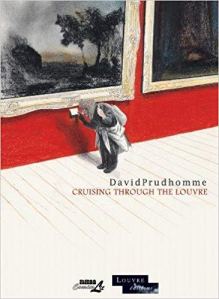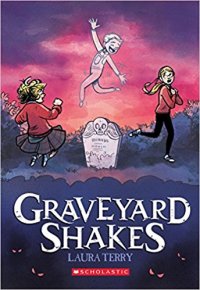Gene: These are small press comics or graphic novels or I’m not quite sure what to call thems by Tillie Walden, who wrote Spinning last year, which I totally loved.
Sarah: I still haven’t read it.
G: For shame!
S: It’s on my list!
G: Spinning was my favorite book of 2017, and I can’t believe it wasn’t in the Top Ten of ALA’s graphic novel list, it didn’t get a Stonewall Award, it didn’t win the Printz. I can’t believe it didn’t win anything. Maybe it was that book committee members thought, well, everyone else is going to give it an award so let’s not worry about it. But I’m pissed on behalf of Tillie Walden. I think it deserved to be featured on all of those lists and more. As soon as I read it I ordered everything else she’d ever written. These were published by a press in the UK I’d never heard of called Avery Hill Publishing.
S: Is Walden British?
G: No, she’s American. And she’s quite young, in her early 20s I think, and I was told that she works so fast she did all the preliminary drawings for Spinning in like 3 months. Apparently she doesn’t pencil anything — she just draws it in ink. So she works incredibly fast. I think this is the order in which these were created. And you’re going to love them so much you’re going to go read Spinning.
I Love This Part by Tillie Walden. Avery Hill, 2015. 9781910395172. 68pp.
 This has one drawing per page, with word balloons, and it’s the story of two young teenage girls in love. The first image is them, and they’re giants in the landscape, totally out of proportion, because, I think, that’s how their love for each other makes them feel. And one of the girls is already talking about way back when she was dumb kid and used to rate everything five stars. They’re already looking at the world like they’re older, smarter, bigger.
This has one drawing per page, with word balloons, and it’s the story of two young teenage girls in love. The first image is them, and they’re giants in the landscape, totally out of proportion, because, I think, that’s how their love for each other makes them feel. And one of the girls is already talking about way back when she was dumb kid and used to rate everything five stars. They’re already looking at the world like they’re older, smarter, bigger.
S: They’re leaning over buildings, towering over the Grand Canyon…
G: It could be that they’re not that big. Sometimes they just look close, like they’re in the foreground. And they’re figuring out their relationship. It’s just moments in a basic layout. And it’s heartbreaking. “Can we ever tell anybody?” “Probably not.”
S: It’s gorgeous and sad.
G: Purples and blacks. Outstanding.
S: It looks great.
The End of Summer by Tillie Walden. Avery Hill, 2016 edition. 9781910395264. 108pp.
 G: This book has a note in an intro by James Sturm, who is a cartoonist and the Director of the Center for Cartoon Studies in Vermont. This is a big oversized trade paperback. He says that in the spring of 2015, Walden was a student there. “She produced a stunning and wistful comic, an impressive achievement for anyone let alone someone so young.” And the he learned she was also doing this at the same time. (I wonder if that project was I Love This Part.) Sturm: “Cartooning is a language, and Tillie speaks it beautifully. As long as she cares to talk I’ll be listening.”
G: This book has a note in an intro by James Sturm, who is a cartoonist and the Director of the Center for Cartoon Studies in Vermont. This is a big oversized trade paperback. He says that in the spring of 2015, Walden was a student there. “She produced a stunning and wistful comic, an impressive achievement for anyone let alone someone so young.” And the he learned she was also doing this at the same time. (I wonder if that project was I Love This Part.) Sturm: “Cartooning is a language, and Tillie speaks it beautifully. As long as she cares to talk I’ll be listening.”
S: Nice.
G: It seems like cartooning is her language. She just writes comics, it feels like she doesn’t have to think about it or figure out the word / image balance or the flow. She makes it seem natural. Maybe this is where we are now.
S: Comics natives.
G: Right. You’ve been brought up in the golden age of kids and YA comics, and now you’re going to start making them. This is dedicated to her twin brother. It’s the story of a family. It’s science fiction. Winter is coming, and will last for three years. A family is being sealed up in a giant mansion. The narrator is Lars, who is 11, and he’s dying. He has a weak heart.
S: Look how intricate those pictures are.
G: Amazing, black and white, it looks like the best manga landscapes I’ve ever seen. So detailed.
S: You couldn’t shrink this down. It would look terrible.
G: You could but it would be a crime.
Lars has a giant cat named Nero. Like the size of a truck. And he rides the cat around. He doesn’t want his siblings to know that he’s dying. He knows he won’t see the end of winter.
Here’s a great page where he introduces his siblings. Per, his cruel brother, scrapes his teeth on his fork as he watches Lars. His sister Maja, his twin I think. There’s some abuse going on in the house. I think teens would love this — it has that quality of looking at your life as a teen. There’s so much space in the house. Per is awful. The parents seem conservative, and the family doesn’t talk about their feelings, but the kids kind of rely on each other. Maja is very pissed off. The focus shifts, but it all works.
S: It reminds me of Moebius a bit.
G: In the grand scale a bit, yeah.
This is her third book, which came out in 2016.
A City Inside by Tillie Walden. Avery Hill, 2016. 9781910395202. 56pp.
 This one is about a young woman going for some therapy session, and then building a reality inside her head as somebody talks to her about where she grew up in the South and where she grew up and why she left. It’s hallucinatory because she’s living in the sky. And she meets someone, she was beautiful, she comes back to earth.
This one is about a young woman going for some therapy session, and then building a reality inside her head as somebody talks to her about where she grew up in the South and where she grew up and why she left. It’s hallucinatory because she’s living in the sky. And she meets someone, she was beautiful, she comes back to earth.
S: A really different use of space!
G: I Love This Part has more of this, you see these two people together so you love them. In this one, she goes from the narrator’s point of view to show the woman she loves. It’s more skillful than showing images of love at a remove. It’s harder to show the person the narrator loves, through her eyes, and getting readers to feel it. It’s sad, but it ends on a tremendously hopeful note.
S: That’s great. It’s so exciting when you find someone like this, and you know they’re going to get better and better.
G: Read Spinning for goodness sake. And here, borrow these from me. [ed: Gene was right, I loved Spinning.]
Bonus:
 This book doesn’t come out until October, but I just read my galley, and Wow! This is a long, quiet science fiction science fiction tale about two girls who fall in love at boarding school. After her love must return to her closed society, the girl tries to find her place in the universe. But she can’t forget the love of her life and so, years later, with the help of a crew that travels space restoring ruins, she undertakes the perilous journey to find her.
This book doesn’t come out until October, but I just read my galley, and Wow! This is a long, quiet science fiction science fiction tale about two girls who fall in love at boarding school. After her love must return to her closed society, the girl tries to find her place in the universe. But she can’t forget the love of her life and so, years later, with the help of a crew that travels space restoring ruins, she undertakes the perilous journey to find her.
Vague, I know. Sorry. It’s a wonderfully slow story full of fish-like spaceships and buildings in the sky featuring the best kind of family, all without a single person who uses masculine pronouns (at least as far as I remember), and it feels like over describing it all would ruin it. Set aside a single afternoon to read it this fall and you won’t be sorry.
And, hey, this was originally a webcomic, and you can still read it here. Be quick!
 Prudhomme’s entry into NBM’s English editions of graphic novels about the Louvre is one of my favorites. It starts with him getting a phone call while staring at Rembrandt’s self portrait, and reflecting on wandering the museum, “It’s like walking inside a giant comic book. There are panels on every wall.” But what he really enjoys is looking at people looking at those panels, and that’s the focus of this book. Tourists peering at paintings while holding up phones, people experiencing private moments that seem almost religious, groups of students on a tour, and of course the mob admiring the Mona Lisa (and ignoring the large painting on the wall across from it) — this is an appreciation of people’s attention and whatever focus they can muster. (My favorite guy in the Mona Lisa mob is ignoring the painting entirely, reading a book.) Prudhomme’s pencils bring the people, the artwork, and the building itself to life in a way that reminds me of being in the museum. The woodwork alone is so intricate that it’s worth a visit by itself. (In fact when I was there years ago with my buddy Dave that’s all he looked at. The docents were very puzzled by his detailed questions about the floors.)
Prudhomme’s entry into NBM’s English editions of graphic novels about the Louvre is one of my favorites. It starts with him getting a phone call while staring at Rembrandt’s self portrait, and reflecting on wandering the museum, “It’s like walking inside a giant comic book. There are panels on every wall.” But what he really enjoys is looking at people looking at those panels, and that’s the focus of this book. Tourists peering at paintings while holding up phones, people experiencing private moments that seem almost religious, groups of students on a tour, and of course the mob admiring the Mona Lisa (and ignoring the large painting on the wall across from it) — this is an appreciation of people’s attention and whatever focus they can muster. (My favorite guy in the Mona Lisa mob is ignoring the painting entirely, reading a book.) Prudhomme’s pencils bring the people, the artwork, and the building itself to life in a way that reminds me of being in the museum. The woodwork alone is so intricate that it’s worth a visit by itself. (In fact when I was there years ago with my buddy Dave that’s all he looked at. The docents were very puzzled by his detailed questions about the floors.)






